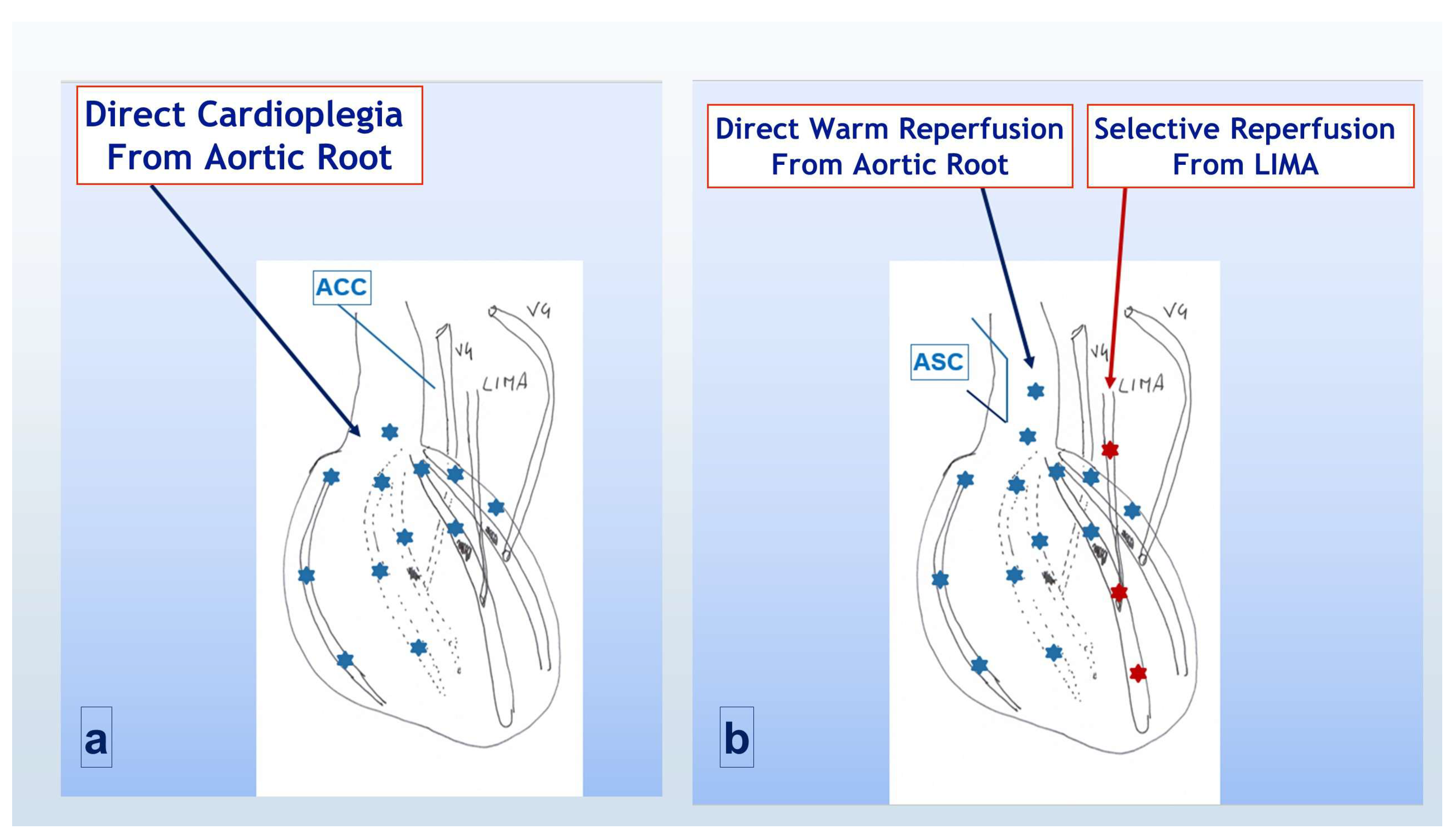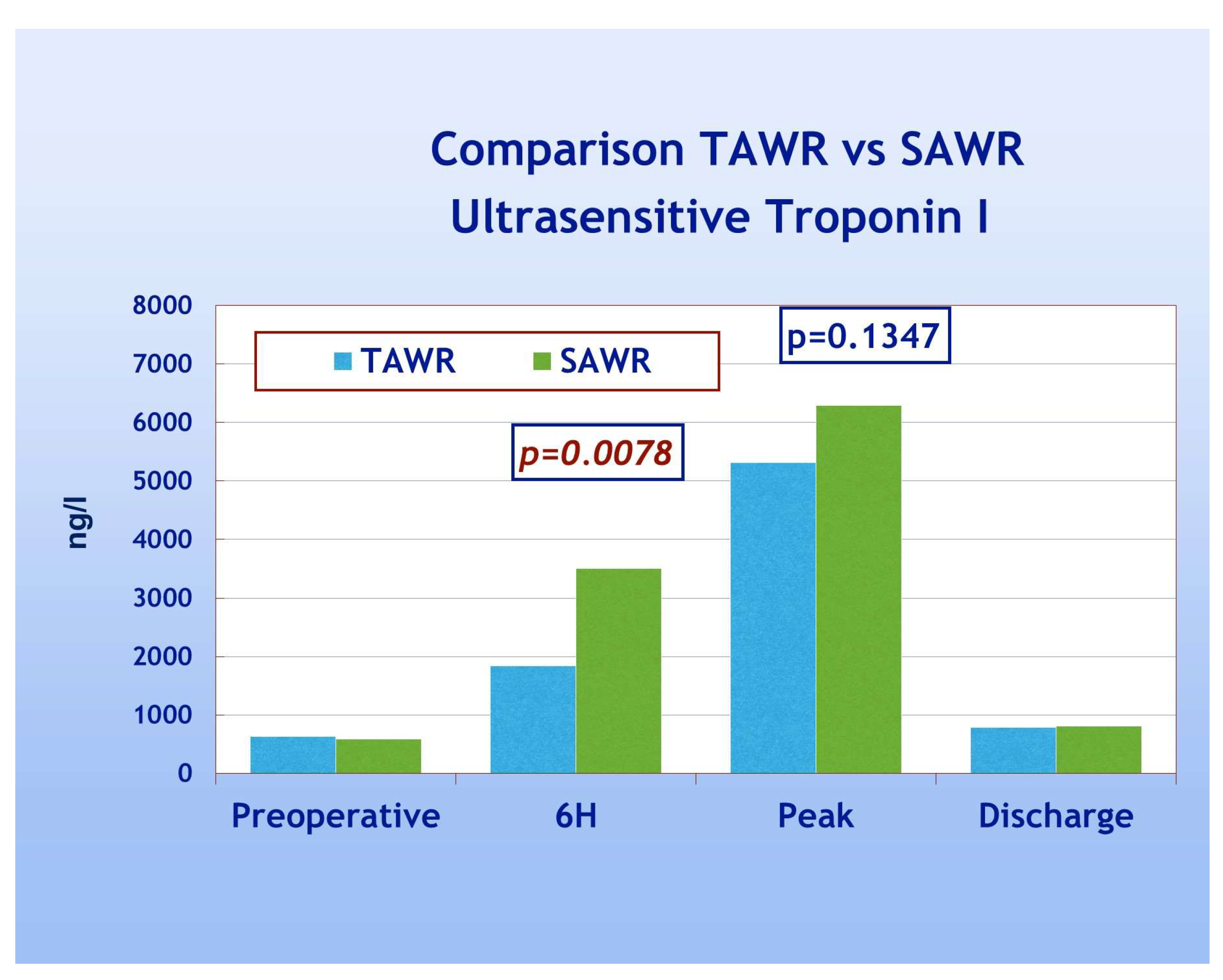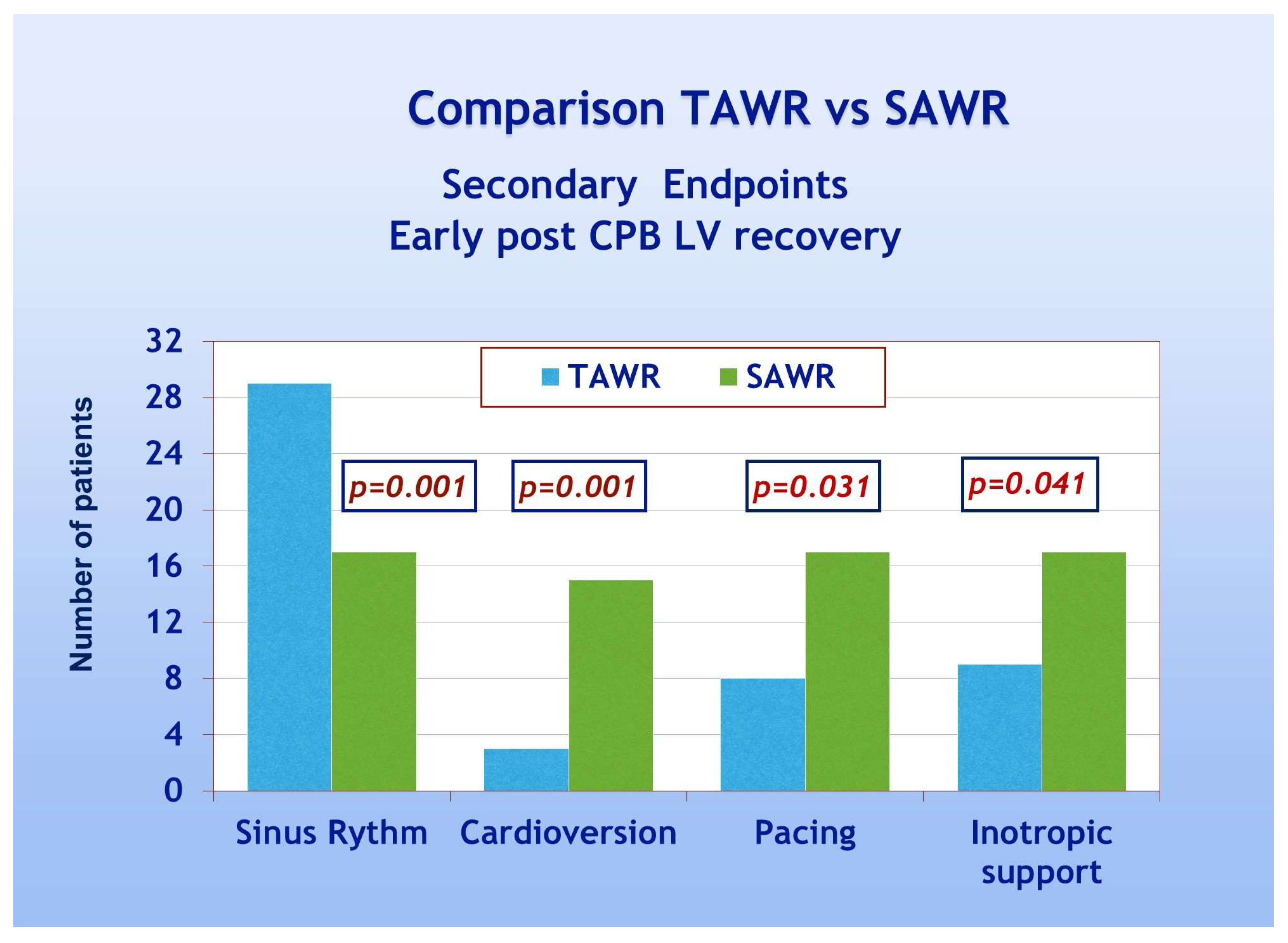Selective Vein Graft Cold Cardioplegia and Warm Reperfusion to Enhance Early Recovery in Patients with Left Ventricle Depression Undergoing Coronary Artery Surgery
Abstract
1. Introduction
2. Materials and Methods
2.1. Detailed Cardioplegia Delivery Protocol
- -
- Induction: Diastolic cardiac arrest is induced by a controlled blood flow of 300 mL/min on average, combined with cardioplegia infusion at a rate of 180–293 mL/h, with a target K+ concentration of up to 20–30 mEq/l. This process is maintained for at least 3 min.
- -
- Maintenance (every 15–20 min or if there is evidence of a heartbeat): After the induction phase, myocardial protection is ensured by intermittent infusion of cardioplegia with maintenance of diastolic arrest by a blood flow of 200 mL/min, while the infusion rate of cardioplegia decreases to 45–83 mL/h. Potassium concentration is adjusted during this phase, which continues for at least 2 min, to 10–15 mEq/l.
2.2. Group A (TAWR)
2.3. Group B (SAWR)
2.4. Statistical Analysis
3. Results
4. Discussion
5. Conclusions
6. Limitations
Author Contributions
Funding
Institutional Review Board Statement
Informed Consent Statement
Data Availability Statement
Acknowledgments
Conflicts of Interest
Abbreviations
Appendix A
| Personal Data | Preoperative Evaluation |
| Age | LVEF |
| Gender | Degree of MR |
| AV Regurgitation | |
| PAP | |
| Medical History | Risk Factors |
| Previous MI | Hypertension |
| Previous PCI | Hyperlipidemia |
| Reason for CABG | Diabetes |
| Combined Mitral Regurgitation | |
| Multivessel Coronary Diseases | |
| COPD | |
| CRF | |
| MI: myocardial infarction; PCI: percutaneous cardiac intervention; COPD: chronic obstructive pulmonary disease; CRF: chronic renal failure; LVEF: left ventricle ejection fraction; MR: mitral regurgitation; AV: aortic valve; PAP: pulmonary artery pressure. | |
Appendix B
| [K+] | CPL | ||||||||
| Blood Flow | [K+] = mEq/l | [K+] = mEq/l | [K+] = mEq/l | [K+] = mEq/l | [K+] = mEq/l | ||||
| 10 | 15 | 20 | 30 | 40 | |||||
| 50 | mL/min | 11 | 21 | 30 | 4 | 68 | mL/h | ||
| 100 | mL/min | 23 | 41 | 60 | 98 | 135 | mL/h | ||
| 150 | mL/min | 34 | 62 | 90 | 146 | 203 | mL/h | ||
| 200 | mL/min | 45 | 83 | 120 | 195 | 270 | mL/h | ||
| 250 | mL/min | 56 | 103 | 150 | 244 | 338 | mL/h | Solution for Cardioplegia Flow | |
| 300 | mL/min | 68 | 124 | 180 | 293 | 405 | mL/h | K+ = 2 mEq/mL + Mg = 2 mEq/mL | |
| 350 | mL/min | 79 | 144 | 210 | 341 | 473 | mL/h | ||
| 400 | mL/min | 90 | 165 | 240 | 390 | 540 | mL/h | ||
| 450 | mL/min | 101 | 186 | 270 | 439 | 608 | mL/h | ||
| 500 | mL/min | 113 | 206 | 300 | 488 | 675 | mL/h | ||
| Details of the cardioplegia infusion protocol during (a) induction (red font and light blue background) and (b) maintenance (green font and light grey background). During induction, the standard target K+ concentration is 20–30 mEq/l, achieved with 300 mL/min of blood flow mixed with 180-293 mL/h of a solution of 2mEq/ml Potassium Chloride and 2mEq/ml of Magnesium Chloride Exaidrate. During maintenance, the standard target K+ concentration is 10–15 mEq/l, achieved with 200 mL/min of blood flow mixed with 45–83 mL/h of the same solution of Potassium and Magnesium. | |||||||||
References
- Grech, E.D. ABC of interventional cardiology: Percutaneous coronary intervention. I: History and development. BMJ 2003, 326, 1080–1082. [Google Scholar] [CrossRef] [PubMed] [PubMed Central]
- Khorsandi, M.; Blumenthal, R.S.; Blaha, M.J.; Kohli, P. The ABCs of the 2023 AHA/ACC/ACCP/ASPC/NLA/PCNA guideline for the management of patients with chronic coronary disease. Clin. Cardiol. 2024, 47, e24284. [Google Scholar] [CrossRef] [PubMed] [PubMed Central]
- Virani, S.S.; Newby, L.K.; Arnold, S.V.; Bittner, V.; Brewer, L.C.; Demeter, S.H.; Dixon, D.L.; Fearon, W.F.; Hess, B.; Johnson, H.M.; et al. 2023 AHA/ACC/ACCP/ASPC/NLA/PCNA Guideline for the Management of Patients With Chronic Coronary Disease: A Report of the American Heart Association/American College of Cardiology Joint Committee on Clinical Practice Guidelines. J. Am. Coll. Cardiol. 2023, 82, 833–955, Erratum in J. Am. Coll. Cardiol. 2023, 82, 1808; Erratum in J. Am. Coll. Cardiol. 2024, 83, 1716. [Google Scholar] [CrossRef] [PubMed]
- Licordari, R.; Costa, F.; Garcia-Ruiz, V.; Mamas, M.A.; Marquis-Gravel, G.; de la Torre Hernandez, J.M.; Gomez Doblas, J.J.; Jimenez-Navarro, M.; Rodriguez-Capitan, J.; Urbano-Carrillo, C.; et al. The Evolving Field of Acute Coronary Syndrome Management: A Critical Appraisal of the 2023 European Society of Cardiology Guidelines for the Management of Acute Coronary Syndrome. J. Clin. Med. 2024, 13, 1885. [Google Scholar] [CrossRef] [PubMed] [PubMed Central]
- Takagi, H.; Matsui, M.; Umemoto, T. Conventional rather than off-pump coronary artery bypass grafting should be performed for non-high-risk patients. J. Thorac. Cardiovasc. Surg. 2011, 141, 1330–1331. [Google Scholar] [CrossRef] [PubMed][Green Version]
- Kowalewski, M.; Pawliszak, W.; Malvindi, P.G.; Bokszanski, M.P.; Perlinski, D.; Raffa, G.M.; Kowalkowska, M.E.; Zaborowska, K.; Navarese, E.P.; Kolodziejczak, M.; et al. Off-pump coronary artery bypass grafting improves short-term outcomes in high-risk patients compared with on-pump coronary artery bypass grafting: Meta-analysis. J. Thorac. Cardiovasc. Surg. 2016, 151, e1–e58. [Google Scholar] [CrossRef] [PubMed]
- Gay, W.A., Jr.; Ebert, P.A. Functional, metabolic, and morphologic effects of potassium-induced cardioplegia. Surgery 1973, 74, 284–290. [Google Scholar] [PubMed]
- Shapira, N.; Kirsh, M.; Jochim, K.; Behrendt, D.M. Comparison of the effect of blood cardioplegia to crystalloid cardioplegia on myocardial contractility in man. J. Thorac. Cardiovasc. Surg. 1980, 80, 647–655. [Google Scholar] [CrossRef] [PubMed]
- Francica, A.; Tonelli, F.; Rossetti, C.; Tropea, I.; Luciani, G.B.; Faggian, G.; Dobson, G.P.; Onorati, F. Cardioplegia between Evolution and Revolution: From Depolarized to Polarized Cardiac Arrest in Adult Cardiac Surgery. J. Clin. Med. 2021, 10, 4485. [Google Scholar] [CrossRef] [PubMed] [PubMed Central]
- Jacob, S.; Kallikourdis, A.; Sellke, F.; Dunning, J. Is blood cardioplegia superior to crystalloid cardioplegia? Interact. Cardiovasc. Thorac. Surg. 2008, 7, 491–498. [Google Scholar] [CrossRef] [PubMed]
- Giordano, P.; Scrascia, G.; D’Agostino, D.; Mastro, F.; Rotunno, C.; Conte, M.; Rociola, R.; Paparella, D. Myocardial damage following cardiac surgery: Comparison between single-dose Celsior cardioplegic solution and cold blood multi-dose cardioplegia. Perfusion 2013, 28, 496–503. [Google Scholar] [CrossRef] [PubMed]
- Zeng, J.; He, W.; Qu, Z.; Tang, Y.; Zhou, Q.; Zhang, B. Cold blood versus crystalloid cardioplegia for myocardial protection in adult cardiac surgery: A meta-analysis of randomized controlled studies. J. Cardiothorac. Vasc. Anesth. 2014, 28, 674–681. [Google Scholar] [CrossRef] [PubMed]
- Sá, M.P.; Rueda, F.G.; Ferraz, P.E.; Chalegre, S.T.; Vasconcelos, F.P.; Lima, R.C. Is there any difference between blood and crystalloid cardioplegia for myocardial protection during cardiac surgery? A meta-analysis of 5576 patients from 36 randomized trials. Perfusion 2012, 27, 535–546. [Google Scholar] [CrossRef] [PubMed]
- Zhou, K.; Zhang, X.; Li, D.; Song, G. Myocardial Protection With Different Cardioplegia in Adult Cardiac Surgery: A Network Meta-Analysis. Heart Lung Circ. 2022, 31, 420–429. [Google Scholar] [CrossRef] [PubMed]
- Misra, S.; Srinivasan, A.; Jena, S.S.; Bellapukonda, S. Myocardial Protection in Adult Cardiac Surgery With del Nido Versus Blood Cardioplegia: A Systematic Review and Meta-Analysis. Heart Lung Circ. 2021, 30, 642–655. [Google Scholar] [CrossRef] [PubMed]
- Yamazaki, K.; Miwa, S.; Ueda, K.; Tanaka, S.; Toyokuni, S.; Unimonh, O.; Nishimura, K.; Komeda, M. Prevention of myocardial reperfusion injury by poly(ADP-ribose) synthetase inhibitor, 3-aminobenzamide, in cardioplegic solution: In vitro study of isolated rat heart model. Eur. J. Cardiothorac. Surg. 2004, 26, 270–275. [Google Scholar] [CrossRef] [PubMed][Green Version]
- Tan, J.; Bi, S.; Li, J.; Gu, J.; Wang, Y.; Xiong, J.; Yu, X.; Du, L. Comparative effects of different types of cardioplegia in cardiac surgery: A network meta-analysis. Front. Cardiovasc. Med. 2022, 9, 996744. [Google Scholar] [CrossRef] [PubMed] [PubMed Central]
- Onorati, F.; Renzulli, A.; De Feo, M.; Santarpino, G.; Gregorio, R.; Biondi, A.; Cerasuolo, F.; Cotrufo, M. Does antegrade blood cardioplegia alone provide adequate myocardial protection in patients with left main stem disease? J. Thorac. Cardiovasc. Surg. 2003, 126, 1345–1351. [Google Scholar] [CrossRef] [PubMed]
- Soltesz, E.G.; Laurence, R.G.; De Grand, A.M.; Cohn, L.H.; Mihaljevic, T.; Frangioni, J.V. Image-guided quantification of cardioplegia delivery during cardiac surgery. Heart Surg. Forum. 2007, 10, E381–E386. [Google Scholar] [CrossRef] [PubMed] [PubMed Central]
- Sanetra, K.; Gerber, W.; Mazur, M.; Kubaszewska, M.; Pietrzyk, E.; Buszman, P.P.; Kaźmierczak, P.; Bochenek, A. Del Nido vs. Cold Blood Cardioplegia for High-Risk Isolated Coronary Artery Bypass Grafting in Patients with Reduced Ventricular Function. Braz. J. Cardiovasc. Surg. 2024, 39, e20220346. [Google Scholar] [CrossRef] [PubMed] [PubMed Central]
- Lorusso, R.; La Canna, G.; Ceconi, C.; Borghetti, V.; Totaro, P.; Parrinello, G.; Coletti, G.; Minzioni, G. Long-term results of coronary artery bypass grafting procedure in the presence of left ventricular dysfunction and hibernating myocardium. Eur. J. Cardiothorac. Surg. 2001, 20, 937–948. [Google Scholar] [CrossRef] [PubMed][Green Version]
- Brown, S.; Nassar, K.; Razzouk, J.; Kashyap, A.K.; Won, M.; Shehadeh, T.; Salabat, R.; Rabkin, D.G.; Chung, J.S. Outcomes of coronary artery bypass surgery using modified del Nido cardioplegia in patients with poor ventricular function. J. Cardiothorac. Surg. 2023, 18, 346. [Google Scholar] [CrossRef] [PubMed] [PubMed Central]
- Tian, G.; Xiang, B.; Dai, G.; Sun, J.; Lindsay, W.G.; Deslauriers, R. Simultaneous antegrade/retrograde cardioplegia protects myocardium distal to a coronary occlusion: A study in isolated pig hearts. Magn. Reson. Med. 2001, 46, 773–780. [Google Scholar] [CrossRef] [PubMed][Green Version]
- Poirier, N.C.; Ugolini, P.; Pellerin, M.; Petitclerc, R.; Tardif, J.C. Transesophageal echocardiographic evaluation of perioperative coronary sinus trauma. Ann. Thorac. Surg. 1998, 66, 573–575. [Google Scholar] [CrossRef] [PubMed]
- Goldman, B.S.; Ovil, Y.; Mycyk, T. A technique for selective graft perfusion during aortocoronary bypass. J. Card. Surg. 1987, 2, 495–498. [Google Scholar] [CrossRef] [PubMed]
- Onem, G.; Sacar, M.; Baltalarli, A.; Ozcan, A.V.; Gurses, E.; Sungurtekin, H. Comparison of simultaneous antegrade/vein graft cardioplegia with antegrade cardioplegia for myocardial protection. Adv. Ther. 2006, 23, 869–877. [Google Scholar] [CrossRef] [PubMed]
- Hatemi Can, A.; Gürsoy, M.; Tongut, A.; Canikoğlu, M.; Kansız, E.; Ulusoy Eralp, R.; Kaya, A.; Ay Pınar, N.; Enar, R.; Sözer Ferda, F.; et al. Myocardial Protection with Simultaneous Antegrade/Vein Graft Cardioplegia Compared to Antegrade Cardioplegia Alone in Elective Coronary Artery Bypass Grafting Patients. Balkan Med. J. 2011, 28, 75–79. [Google Scholar] [CrossRef]
- Goncu, M.T.; Sezen, M.; Toktas, F.; Ari, H.; Gunes, M.; Tiryakioglu, O.; Yavuz, S. Effect of antegrade graft cardioplegia combined with passive graft perfusion in on-pump coronary artery bypass grafting. J. Int. Med. Res. 2010, 38, 1333–1342. [Google Scholar] [CrossRef] [PubMed]
- Sharifi, M.; Mousavi, S.R.; Rafiei, M. Our modified technique of combined antegrade-vein graft cardioplegia infusion versus conventional antegrade method in coronary artery bypass grafting. A randomized clinical trial. Int. J. Surg. 2018, 55, 53–59. [Google Scholar] [CrossRef] [PubMed]
- Ali, M.; Moeen, M.; Paras, I.; Hamid, W.; Khan, S.; Chaudhary, M.H. Cardio-Protective Effects of Multiport Antegrade Cold Blood Cardioplegia Versus Antegrade Cold Blood Cardioplegia in Patients With Left Ventricular Systolic Dysfunction Undergoing Conventional Coronary Artery Bypass Grafting. Cureus 2020, 12, e10308. [Google Scholar] [CrossRef] [PubMed] [PubMed Central]
- Mauro, M.D.; Calafiore, A.M.; Di Franco, A.; Nicolini, F.; Formica, F.; Scrofani, R.; Antona, C.; Messina, A.; Troise, G.; Mariscalco, G.; et al. Association between cardioplegia and postoperative atrial fibrillation in coronary surgery. Int. J. Cardiol. 2021, 324, 38–43. [Google Scholar] [CrossRef] [PubMed] [PubMed Central]
- Narayan, P.; Angelini, G.D. Warm blood or cold cardioplegia—Is this the final answer? Int. J. Cardiol. 2021, 322, 99–100. [Google Scholar] [CrossRef] [PubMed]
- Ferguson, Z.G.; Yarborough, D.E.; Jarvis, B.L.; Sistino, J.J. Evidence-based medicine and myocardial protection—Where is the evidence? Perfusion 2015, 30, 415–422. [Google Scholar] [CrossRef] [PubMed]
- Bradić, J.; Andjić, M.; Novaković, J.; Jeremić, N.; Jakovljević, V. Cardioplegia in Open Heart Surgery: Age Matters. J. Clin. Med. 2023, 12, 1698. [Google Scholar] [CrossRef] [PubMed] [PubMed Central]





| Personal Data | Group A TAWR (n.32) | Group B SAWR (n.32) | p |
| Gender | 0.5452 | ||
| Male | 24 (75) | 26 (81) | |
| Female | 8 (25) | 6 (19) | |
| Age | 0.704 | ||
| Mean ± sd (years) | 68 ± 10 | 67 ± 11 | |
| >75 years | 15 (47) | 15 (47) | |
| Comorbidities | Group A | Group B | p |
| Diabetes | 18 (56) | 17 (53) | 0.803 |
| Hypertension | 21(65) | 22 (68) | 0.788 |
| Smoking History | 20 (62) | 19 (59) | 0.797 |
| Hypercholesteloremia | 19 (59) | 20 (62) | 0.797 |
| COPD | 11(34) | 10 (31) | 0.795 |
| Chronic Renal Failure | 9 (28) | 10 (31) | 0.784 |
| Cardiac Parameters | Group A | Group B | p |
| Previous MI | 20 (62) | 18 (56) | 0.601 |
| Previous Stent-PCI | 16 (50) | 11 (34) | 0.205 |
| LVEF | |||
| Mean ± sd | 33 ± 4 | 34 ± 5 | 0.542 |
| <30% | 9 (28) | 8 (25) | 0.777 |
| Mitral Regurgitation | |||
| Trivial | 8 (25) | 9 (28) | 0.777 |
| Moderate | 3 (9) | 2 (6) | 0.642 |
| Aortic Regurgitation | 0.688 | ||
| Trivial | 4 (12) | 3 (9) | |
| Moderate | 0 | 0 | |
| PAPs > 40mmHg | 3 (9) | 2 (6) | 0.642 |
| Operative Parameters | Group A TAWR (n.32) | Group B SAWR (n.32) | p |
|---|---|---|---|
| Number of Grafts | 3.5 ± 0.6 | 3.4 ± 0.5 | 0.37 |
| Single IMA Double IMA | 30 (94) 2 (6) | 31 (97) 1 (3) | 0.98 0.97 |
| Surgical Time (min) | 270 ± 66 | 256 ± 80 | 0.48 |
| ECC Time (min) | 104 ± 15 | 103 ± 11 | 0.65 |
| Cross-Clamp Time (min) | 70 ± 10 | 68 ± 10 | 0.69 |
| Side-Clamp Time (min) | 27 ± 7 | 26 ± 4 | 0.56 |
| Group | T0 Preoperative (TTE LVEF) | T1 Intraoperative ° (TEE LVEF) | T2 Discharge (TTE LVEF) | p |
|---|---|---|---|---|
| TAWR | 33 ± 4% | 38 ± 3% * | 40 ± 3% * | 0.001 * Vs. T0 |
| SAWR | 34 ± 5% | 37 ± 5% * | 39 ± 4% * | 0.001 * Vs. T0 |
| p | 0.542 | 0.55 | 0.18 |
Disclaimer/Publisher’s Note: The statements, opinions and data contained in all publications are solely those of the individual author(s) and contributor(s) and not of MDPI and/or the editor(s). MDPI and/or the editor(s) disclaim responsibility for any injury to people or property resulting from any ideas, methods, instructions or products referred to in the content. |
© 2025 by the authors. Licensee MDPI, Basel, Switzerland. This article is an open access article distributed under the terms and conditions of the Creative Commons Attribution (CC BY) license (https://creativecommons.org/licenses/by/4.0/).
Share and Cite
Totaro, P.; Musto, M.; Tulumello, E.; Degani, A.; Argano, V.; Pelenghi, S. Selective Vein Graft Cold Cardioplegia and Warm Reperfusion to Enhance Early Recovery in Patients with Left Ventricle Depression Undergoing Coronary Artery Surgery. J. Cardiovasc. Dev. Dis. 2025, 12, 222. https://doi.org/10.3390/jcdd12060222
Totaro P, Musto M, Tulumello E, Degani A, Argano V, Pelenghi S. Selective Vein Graft Cold Cardioplegia and Warm Reperfusion to Enhance Early Recovery in Patients with Left Ventricle Depression Undergoing Coronary Artery Surgery. Journal of Cardiovascular Development and Disease. 2025; 12(6):222. https://doi.org/10.3390/jcdd12060222
Chicago/Turabian StyleTotaro, Pasquale, Martina Musto, Eduardo Tulumello, Antonella Degani, Vincenzo Argano, and Stefano Pelenghi. 2025. "Selective Vein Graft Cold Cardioplegia and Warm Reperfusion to Enhance Early Recovery in Patients with Left Ventricle Depression Undergoing Coronary Artery Surgery" Journal of Cardiovascular Development and Disease 12, no. 6: 222. https://doi.org/10.3390/jcdd12060222
APA StyleTotaro, P., Musto, M., Tulumello, E., Degani, A., Argano, V., & Pelenghi, S. (2025). Selective Vein Graft Cold Cardioplegia and Warm Reperfusion to Enhance Early Recovery in Patients with Left Ventricle Depression Undergoing Coronary Artery Surgery. Journal of Cardiovascular Development and Disease, 12(6), 222. https://doi.org/10.3390/jcdd12060222







